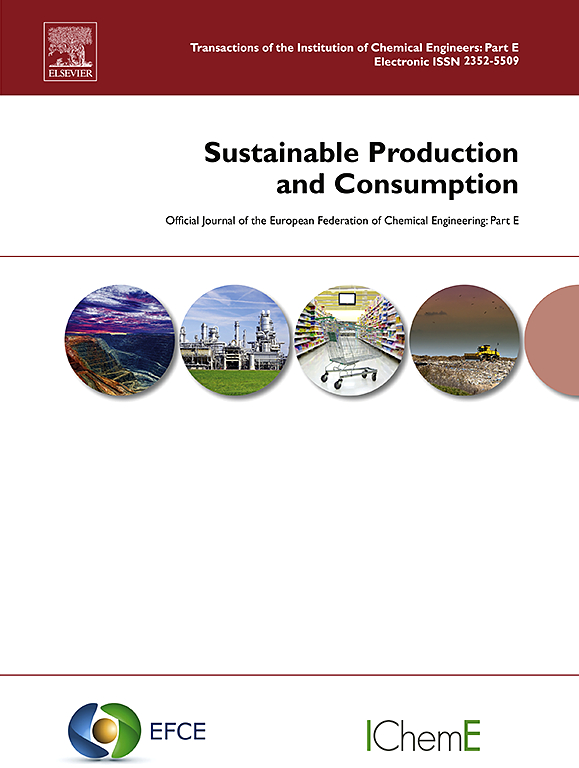考虑中国太阳能光伏-电池-电网系统不同配置的水电解制氢可持续性评估
IF 9.6
1区 环境科学与生态学
Q1 ENVIRONMENTAL STUDIES
引用次数: 0
摘要
可再生或“绿色”氢已成为帮助缓解气候变化的一个有希望的选择。鉴于中国丰富的太阳能资源,利用太阳能制氢可能是中国可行的途径,但目前其可持续性尚不清楚。因此,本研究评估了以太阳能光伏发电(PV)为主要能源的聚合物电解质膜电解(PEMWE)可再生制氢的生命周期环境和经济可持续性。考虑了三种光伏系统配置:独立式光伏(SPV)、带电池存储的离网式光伏(BPV)和并网式光伏(GPV)。研究结果表明,SPV具有优越的环保性能。例如,它对气候变化的影响最低,为4.3-6.5吨二氧化碳当量/吨氢气,代表BPV减少14 - 30%,相对于GPV大幅减少84 - 90%。与BPV相比,SPV在其他影响方面也显示出显著的减少(4 - 78%)。虽然SPV具有更高的土地利用和金属消耗(9 - 170%),并且与GPV具有相似的生态毒性影响,但它在水、土壤和空气污染、化石消耗、淡水消耗和非癌症人类毒性(18个类别中的11个)方面实现了显着减少(16 - 90%)。然而,SPV是第二昂贵的配置,其生命周期成本为1581-2412万美元,氢(LCOH)的平化成本为3953-6029美元/吨。GPV是成本的最佳选择(1047-1570亿美元和2741-4048美元/吨),而BPV的成本大约是GPV的三倍(4405 - 51.8亿美元和11134 - 12951美元/吨)。展望2050年,随着电网结构的变化,GPV在气候变化、化石燃料消耗、水消耗、人类毒性以及水、土壤和空气污染相关影响方面提供了18 - 79%的减少,但相对于目前的电网结构,电离辐射、土地利用、金属消耗和生态毒性增加了2 - 244%。目前,SPV在包括气候变化在内的4个影响方面优于蒸汽甲烷重整,在9个影响方面优于煤气化,但其LCOH高于两种传统工艺(1240-2480美元/吨)。GPV是目前与传统路线相比唯一具有经济竞争力的选择,但与SPV相比,它在环境方面并不理想。这项研究为在中国不同地区和时间范围内选择PEMWE制氢的最佳配置提供了新的见解,将引起技术开发商、投资者和政策制定者的兴趣。本文章由计算机程序翻译,如有差异,请以英文原文为准。

Sustainability assessment of hydrogen production via water electrolysis considering different configurations of solar photovoltaics-battery-grid systems in China
Renewable or “green” hydrogen has emerged as a promising option to help mitigate climate change. Given China's abundant solar resources, hydrogen produced using solar energy could be a viable pathway for the country but at present its sustainability is unknown. Therefore, this study evaluates the life cycle environmental and economic sustainability of renewable hydrogen production via polymer electrolyte membrane water electrolysis (PEMWE) using solar photovoltaics (PV) as the main source of energy. Three PV system configurations are considered: a standalone PV (SPV), an off-grid PV with battery storage (BPV) and a grid-connected PV (GPV). The findings reveal the superior environmental performance of SPV. For instance, it has the lowest climate change impact of 4.3–6.5 t CO2 eq./t H2, representing a 14–30 % reduction on BPV and a substantial 84–90 % decrease relative to GPV. SPV also shows notable reductions (4–78 %) across the other impacts in comparison with BPV. While SPV has higher land use and metal depletion (9–170 %) and similar ecotoxicity impacts to GPV, it achieves significant reductions (16–90 %) in the water, soil and air pollution, fossil depletion, freshwater consumption and non-cancer human toxicity (11 out of 18 categories). However, SPV is the second most expensive configuration, with the life cycle costs of 1581–2412 M$ and levelised costs of hydrogen (LCOH) of 3953–6029 $/t. GPV is the best option for costs (1047–1570 M$ and 2741–4048 $/t), while the costs of BPV are around three times as high (4405–5180 M$ and 11,134–12,951 $/t). Looking ahead to 2050, with prospective changes in the grid composition, GPV offers 18–79 % reductions in the climate change, fossil depletion, water consumption, human toxicity and water, soil and air-pollution related impacts, but increases ionising radiation, land use, metal depletion and ecotoxicity by 2–244 % relative to the current grid mix. Currently, SPV outperforms steam methane reforming in four impacts and coal gasification in nine, including climate change, but has a higher LCOH than both conventional processes (1240–2480 $/t). GPV is currently the only option economically competitive with the conventional routes, but it is suboptimal environmentally compared to SPV. This research provides new insights into the selection of optimal configurations for PEMWE hydrogen production in China across different regions and time horizons and will be of interest to technology developers, investors and policy makers.
求助全文
通过发布文献求助,成功后即可免费获取论文全文。
去求助
来源期刊

Sustainable Production and Consumption
Environmental Science-Environmental Engineering
CiteScore
17.40
自引率
7.40%
发文量
389
审稿时长
13 days
期刊介绍:
Sustainable production and consumption refers to the production and utilization of goods and services in a way that benefits society, is economically viable, and has minimal environmental impact throughout its entire lifespan. Our journal is dedicated to publishing top-notch interdisciplinary research and practical studies in this emerging field. We take a distinctive approach by examining the interplay between technology, consumption patterns, and policy to identify sustainable solutions for both production and consumption systems.
 求助内容:
求助内容: 应助结果提醒方式:
应助结果提醒方式:


